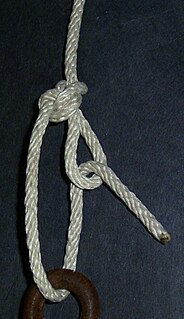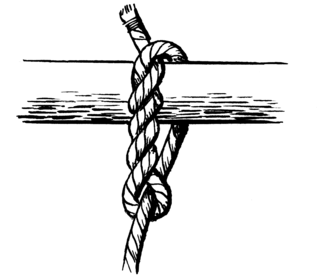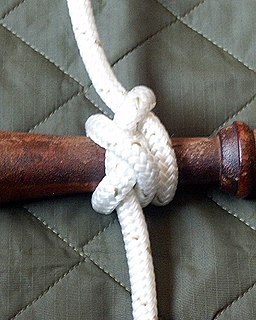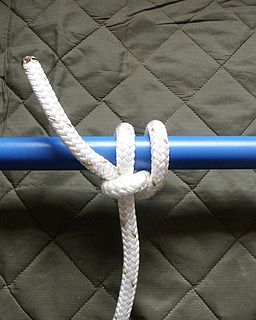
A knot is an intentional complication in cordage which may be practical or decorative, or both. Practical knots are classified by function, including hitches, bends, loop knots, and splices: a hitch fastens a rope to another object; a bend fastens two ends of a rope to each another; a loop knot is any knot creating a loop, and splice denotes any multi-strand knot, including bends and loops. A knot may also refer, in the strictest sense, to a stopper or knob at the end of a rope to keep that end from slipping through a grommet or eye. Knots have excited interest since ancient times for their practical uses, as well as their topological intricacy, studied in the area of mathematics known as knot theory.

The constrictor knot is one of the most effective binding knots. Simple and secure, it is a harsh knot that can be difficult or impossible to untie once tightened. It is made similarly to a clove hitch but with one end passed under the other, forming an overhand knot under a riding turn. The double constrictor knot is an even more robust variation that features two riding turns.

The trucker's hitch is a compound knot commonly used for securing loads on trucks or trailers. This general arrangement, using loops and turns in the rope itself to form a crude block and tackle, has long been used to tension lines and is known by multiple names. Knot author Geoffrey Budworth claims the knot can be traced back to the days when carters and hawkers used horse-drawn conveyances to move their wares from place to place.
A whipping knot or whipping is a binding of marline twine or whipcord around the end of a rope to prevent its natural tendency to fray.
A versatackle is a self-locking tensioning structure implemented in cordage. It consists of two loops with the rope passed back and forth between them. It is functionally similar to the trucker's hitch, however, unlike the trucker's hitch, the versatackle is self-locking under tension.

The timber hitch is a knot used to attach a single length of rope to a cylindrical object. Secure while tension is maintained, it is easily untied even after heavy loading.

The heaving line bend is a knot for securely joining two ropes of different diameter or rigidity. It is often used to affix playing strings to the thick silk eyes of an anchorage knot in some stringed instruments. In nautical use, the heaving line bend is used to connect a lighter messenger line to a hawser when mooring ships. It is knot number 1463 in The Ashley Book of Knots, and appeared in the 1916 Swedish knot manual Om Knutar.

A fireman's chair knot is a knot tied in the bight forming two adjustable, lockable loops. The knot consists of a handcuff knot finished with a locking half hitch around each loop. The loops remain adjustable until the half hitches are tightened.

The Highwayman’s hitch is a quick-release draw hitch used for temporarily securing a load that will need to be released easily and cleanly. The hitch can be untied with a tug of the working end, even when under tension. The highwayman's hitch can be tied in the middle of a rope, and so the working end does not need to be passed around the anchor when tying or releasing.

The buntline hitch is a knot used for attaching a rope to an object. It is formed by passing the working end around an object, then making a clove hitch around the rope's standing part and taking care that the turns of the clove hitch progress towards the object rather than away from it. Secure and easily tied, the buntline hitch will jam when subjected to extreme loads. Given the knot's propensity to jam, it is often made in slipped form.
The buntline hitch, when bent to a yard, makes a more secure knot than two half hitches, but is more liable to jam. It differs from two half hitches in that the second half hitch is inside instead of outside the first one.

The adjustable grip hitch is a simple and useful friction hitch which may easily be shifted up and down the rope while slack. It will hold fast when loaded, but slip when shock loaded until tension is relieved enough for it to again hold fast.

The adjustable bend is a bend knot that is easy to lengthen or shorten.

The International Guild of Knot Tyers is a worldwide association for people with an interest in knots and knot tying.

In knot tying, a bight is a curved section or slack part between the two ends of a rope, string, or yarn. A knot that can be tied using only the bight of a rope, without access to the ends, is described as in the bight. The term "bight" is also used in a more specific way when describing Turk's head knots, indicating how many repetitions of braiding are made in the circuit of a given knot.
The boom hitch is a type of knot. It is a rather robust and secure method of attaching a line, or rope to a fixed object like a pipe, post, or sail boom.

The snuggle hitch is a modification of the clove hitch, and is stronger and more secure. Owen K. Nuttall of the International Guild of Knot Tyers came up with this unique hitch, and it was first documented in the Guild's Knotting Matters magazine issue of January, 1987. Generally, hitches are used to attach a line to another rope or spar, pole, etc., and are usually temporary. Thus, they should be relatively easy to untie.

The ossel hitch is a knot used to attach a rope or line to an object. It was originally used on Scottish gill nets to tie small line to larger rope that supported the net. Ossel is actually the Scottish word for "gill net" and for the line attaching the net to the float rope.

The diamond hitch is a lashing technique used mainly in the field of equine packing, to secure a set of objects, for instance a pair of pack-bags, pack-boxes or other gear onto a base, for instance a pack saddle frame, in which case it requires the use of a lash cinch. In the general sense it requires the base to be equipped with at least two points of anchorage, and a rope which is used to lash the object down onto the base. There are two types of Diamond Hitches, a single, shown here, and a double diamond hitch which is not shown.
















